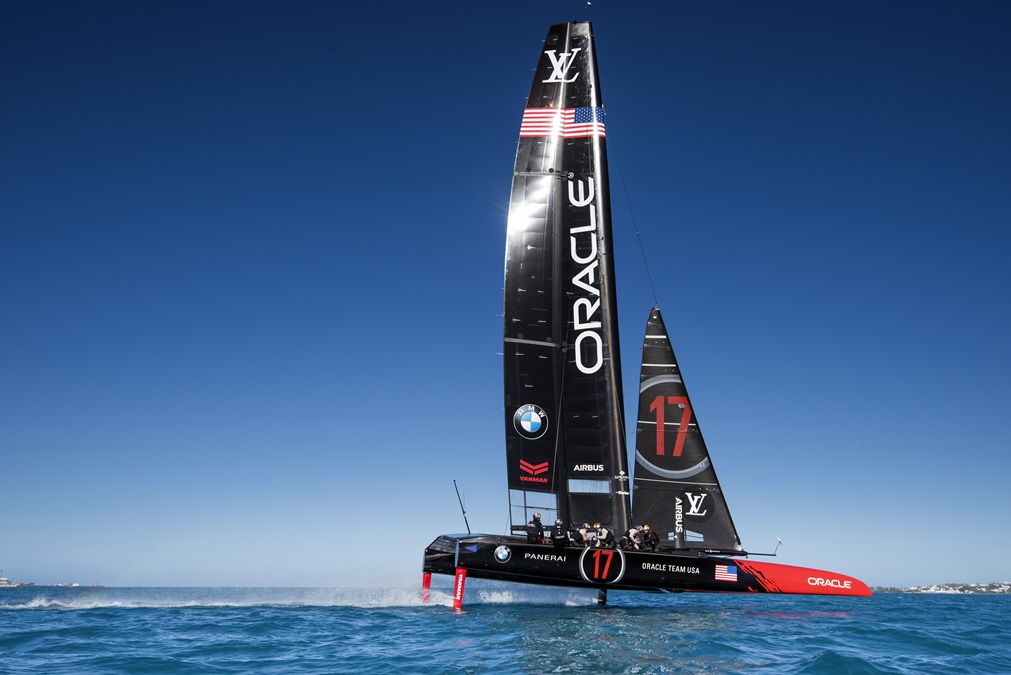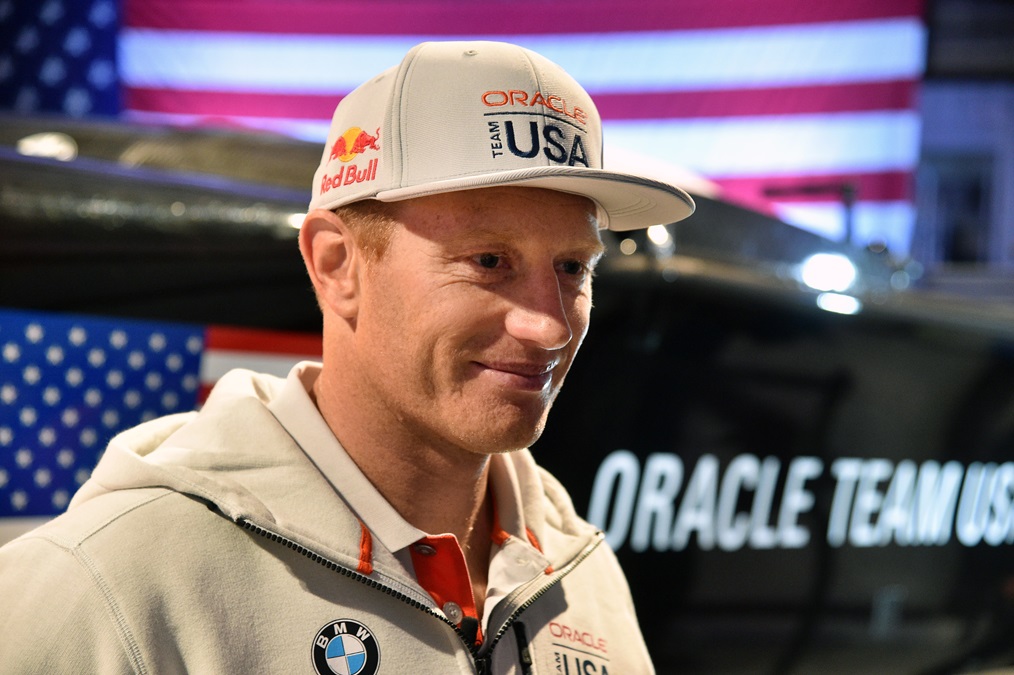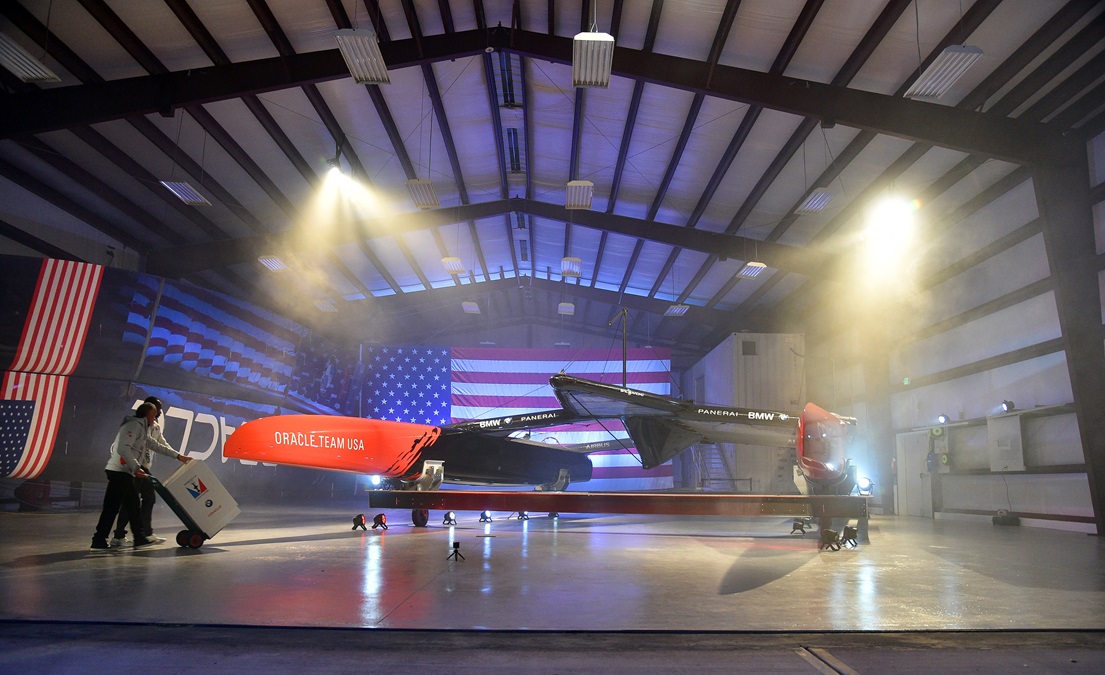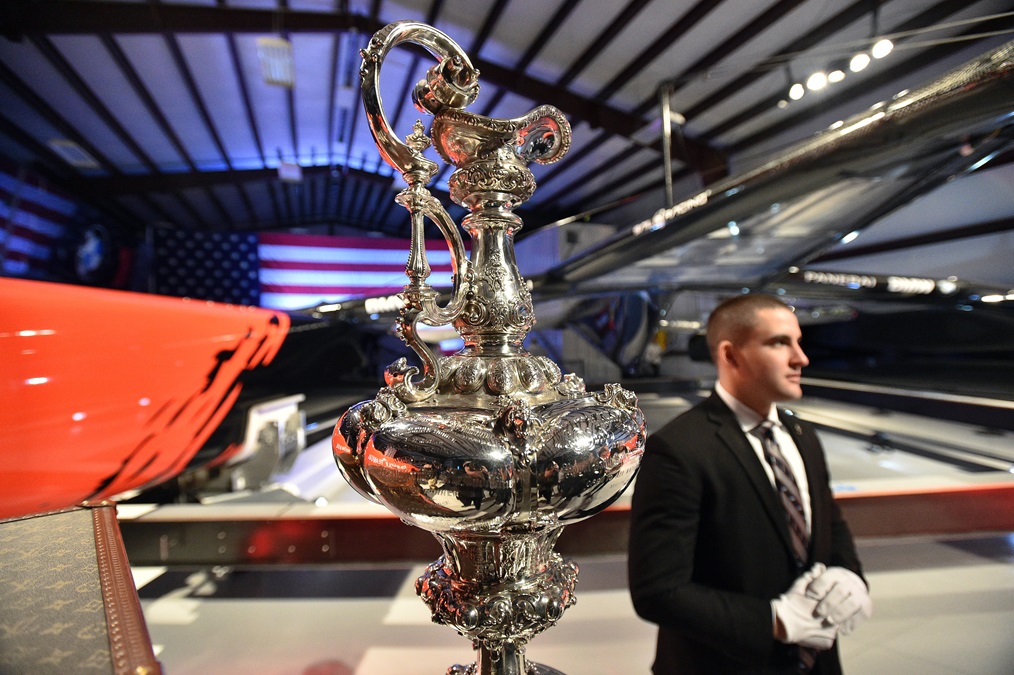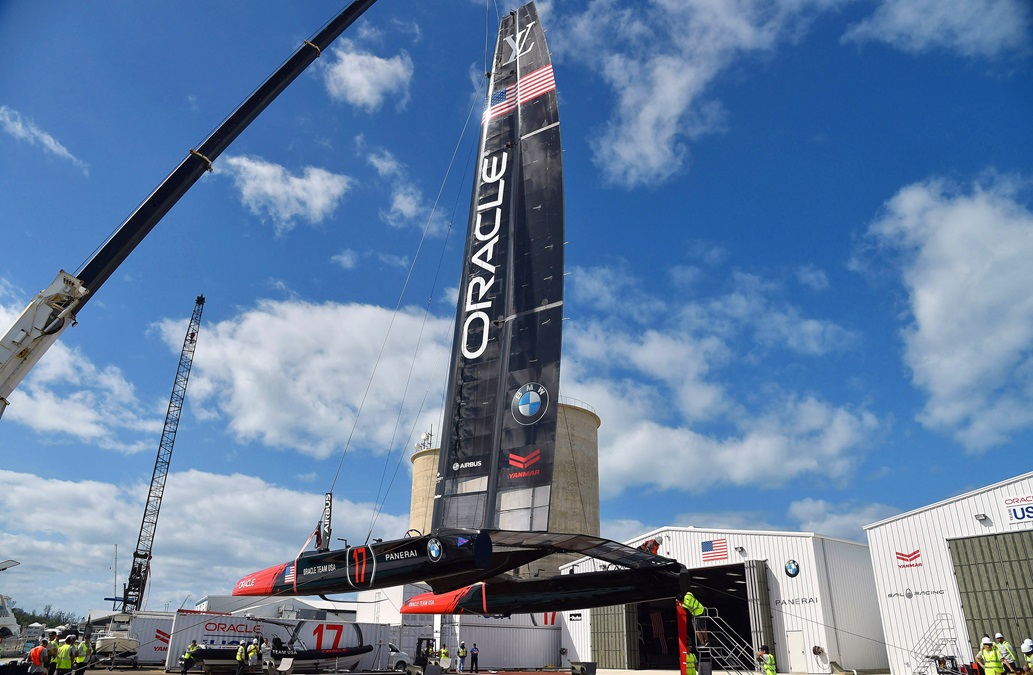Water flying
Aviation technology powers the USA racing yacht

A: Airbus A320-inspired sharklet foils control the ship’s attitude in and above the water.
B: Hydrodynamic forces act on the ship’s sharklet foils when they are submerged, and aerodynamic forces affect the foils when they are in the windstream.
C: The main sail’s leading edge is dotted with 400 nonintrusive microelectromechanical systems (MEMS) that feed real-time weather information to the skipper. These have aviation potential as wing flow sensors and anti-stall devices.
D: The racing yacht uses strong, lightweight composite materials and techniques borrowed from aviation, such as honeycomb construction and 3-D printing.
E: Consisting of a stationary main section and an articulating second element, the rigid wing sail produces more than twice the lift of a conventional sail. It is controlled by hydraulic pressure.
F: Submerged rudders and articulating horizontal foils are similar to an inverted aircraft T-tail. The rudders help steer, while elevators help control the pitch attitude of the ship.
Sailing aficionados following the United States’ towering black-and-red entry in the thirty-fifth America’s Cup competition might be astounded to learn how much the ocean-going vessel resembles an aircraft. From the pointy-nosed carbon-fiber bowsprit to the dagger-like rudders and bat-wing-shape black elevators keeping the ship just above a turquoise bay, the Oracle Team USA racing yacht is every bit a flier.
The twin-hulled sailing ship borrows heavily from aviation to get an edge as the team defends the oldest title in team sports. Airbus-engineered, hydraulically controlled twin airfoils provide lift from sharklet-shape horizontal wings tucked under each hull. The wings can raise the 2.5-ton ship from the water’s surface. Twin rudders and elevators protruding from the stern, which barely attach the ship to the ocean, provide directional stability, and keep it from doing a wheelie in a nose-high attitude. A towering, 79-foot-tall wing-and-flap sail system can be twisted and cambered to efficiently harness wind for power and speed. Computational fluid dynamics analysis from Airbus calculates the ship’s aerodynamics in—and above—the water. Microelectromechanical systems (MEMS) spaced along the sail’s leading edge evaluate localized barometric pressure and wind data in real time to optimize performance. The result is a masterpiece of aerodynamic design and technology that skims the water at breakneck speeds.
“We are literally now flying above the water,” said skipper and private pilot Jimmy Spithill, describing the racing yacht he will command against the winner of teams from France, Great Britain, Japan, New Zealand, and Sweden in Bermuda in June. “It’s very similar to an aircraft,” added Spithill, who earned his private pilot certificate in a Cessna 150 and is now taking helicopter lessons. The sleek vessel clearly has more in common with composite-constructed jet aircraft than the wood-and-fabric sailing sloops from the earliest days of the America’s Cup competition.
Sea change
Aviation technologies including aerodynamics, wind-tunnel testing, and lightweight material have brought improvements to boats in the competition for more than 25 years. Until then, competitors sailed behind 12-meter-long, single-hull yachts flying fabric sails that hearkened back to the sloops of yesteryear.
The 1983 aircraft-inspired Australia II looked traditional above the waterline—but below, the hull was shrouded in mystery. To preserve its secret, the Australian yacht’s winged keel was famously cloaked each time the boat was hoisted from or lowered into the ocean. The wing design propelled Aussie skipper Ben Lexcen to defeat American skipper Dennis Conner’s Liberty, a crushing blow that took the Cup away from the United States for the first time in its 132-year history.
It was a turning point in racing yacht design. Australia’s Sails magazine wrote that the “assault on the Cup” had never before reached “such extreme heights of intensity and fierce rivalry,” with “pressure on the Americans at a fever pitch.”
Rigid sails were a logical next move. Aircraft designer Burt Rutan’s controversial rigid sail topped the United States’ entry in the 1988 America’s Cup. The stiff-battened vertical “wing,” which resembled a wing from Rutan’s Voyager earthrounder aircraft, was mounted atop a twin-hulled catamaran and sailed against New Zealand’s 30-ton hull, a carbon-fiber/nylon-honeycomb sandwich, and 16-story-tall fabric sail. The Los Angeles Times wrote that the Kiwis’ 120-foot-long ship was “the tallest racing mast in the world,” while the American entry’s 60-foot-long twin hull design was “mated with what amounts to an airplane wing standing on end.” Sailing aficionados refer to the matchup as the “cat versus dog” race, where Conner’s nimble cat trounced the Kiwi’s lethargic dog by more than 18 minutes in the first race.
The stiff vertical airfoil turned the sport on its end, spurring lawsuits, countersuits, and a mad scramble to keep up with technology. Conner and his Stars & Stripes crew ultimately wrested the sought-after sailing trophy from Australia II’s entry. New tech soundly defeated old tech as engineering took center stage, and the sport has never looked back.
The power of lift
Gone are the ropes and pulleys that most sailors know. They are replaced by airliner-inspired flaps, wings, and hydraulic fluid.
As the defending champion, Oracle Team USA dictates most of the parameters for the 2017 America’s Cup race (see “Inside the Rulebook,” page 63). “We went with the rigid wing because you can get it the perfect shape for the wind condition and it’ll never collapse. It’s obviously aerodynamic,” said Spithill, “but not only that, it can produce two and a half times more lift coefficient than a conventional sail with the same planform. They’re very, very powerful. The only downside is you need a crane to lift the sail onto the boat, and if conditions get bad you obviously can’t just pull it down.” During a 2012 preliminary race in San Francisco leading to the 2013 America’s Cup race, the U.S. boat with a similar sail capsized in high winds.
The main element of the seven-story-tall sail wing is shaped like a “D” at its leading edge and is covered with “sort of a shrink-wrapped membrane,” explained Pierre-Marie Belleau, the head of Airbus business development. As a technology partner for Oracle Team USA, Airbus contributes the expertise of its engineers. “The second element [of the main sail] is on hinges and is controlled by hydraulics,” similar to an airplane flap. “Airplanes put flaps out to land in a high wind coefficient and that’s the purpose of it,” Belleau said. By applying varying hydraulic pressure to three sets of trailing flaps, the overall sail contour can be adjusted to a particular shape, depending on weather conditions. “The guys can change the wing camber all the time.”
“Just like an airplane landing, we want to get a really high lift coefficient and generate more force—and we’ll put that flap at a really high angle, pretty much like an airplane landing,” said Ian “Fresh” Burns, Oracle Team USA’s director of performance. “If we can get a high angle of attack, we can generate more force and get more energy into the boat, and go faster. It’s very similar to an airplane wing. In fact, it looks just like an airplane wing with maybe a little bigger flap and a little bit smaller main element.”
Articulating horizontal foils situated under the catamaran’s hulls gracefully lift the ship from the water’s surface, much like the wing of an aircraft. The slender horizontal wings are individually controlled by pumping hydraulic fluid through their control mechanisms to tilt the devices forward or backward, similar to an airplane’s elevator. The foil profiles are similar to the silhouette of the Airbus A320 “sharklet” wing tips, developed to improve the efficiency of the European-designed jetliner’s wing.
Power is generated by hand to manipulate the hydraulics that control the angle of attack for the twin sharklet-shape foils. Crewmembers called “grinders” rapidly churn cranks and generate 300 watts of human energy (or about one-half a horsepower) to power and pressurize the system. Spithill jabs pushbuttons on a BMW-designed automobile-style red control wheel to squirt hydraulic fluid to the far reaches of the ship’s plumbing. Like a pilot, Spithill regulates wings, flaps, rudders, and elevators to keep the entire rig trimmed at just the right angle.
Depending on wind conditions, Spithill and crew adjust the airfoils fore and aft, up and down, seeking the sweet spot between lift and drag to harness wind energy. The trick, said Spithill, is to maximize lift—which equals speed—while avoiding an aerodynamic stall that could slap the 5,291-pound vessel and its crew of six back onto the water. The delicate balancing act allows the yacht to cut through the water with ease while the catamaran hulls free themselves from drag—when the ship flies vertically, charges ahead, and accelerates rapidly. The lurch upward and away is reminiscent of a cross between a helicopter and a spawning salmon.
“These boats go two to three times the speed of the wind,” and are capable of sailing at 60 mph, said Spithill. “The beauty of the foil system is that it can lift this entire ship out of the water and get rid of that hydrodynamic drag.”
The sharklet wings are “moving all the time” through the air to provide lift, while the submerged rear elevators help control the overall pitch of the ship, like an aircraft’s. “Most airplanes, if you let go of the stick, you’ll go straight,” said Burns. “If you let go of the stick on our boat, it’ll do a wheelie.” Burns said the yacht is “on that middle ground where you need the input from a skipper, because the two key ingredients are how fast his reactions are and how good the control system is.”
When the horizontal wings were adopted, he estimated that the ships initially flew above the water about 50 percent of the time. With experience that figure rose to 80 percent fairly quickly, “and now we’re up to 90 percent flying,” said Burns. It’s now likely “we can fly the whole race, 100 percent of the time,” but not without “a great control system and a crew that can handle it.” The boats “travel very fast, about 30 knots upwind and about 35 to 40 [knots] downwind.”
Flight control systems specialist Xavier Pol is among the Airbus engineers on loan to the racing team to coax even the smallest advantages from the aerodynamic systems. “It’s like a jet fighter” said Pol, who earned his glider pilot certificate in France at age 16. He said engineers are challenged with designing controls that are comfortable, efficient, and reliable as the crew hops from one side of the ship to the other, depending on wind direction and desired track. Saltwater uncomfortably stings the crew as they charge through the race course; it threatens the high-tech gadgetry even more.
Bellau sees similarity between aviation technology and sailboat racing. Additive layer manufacturing (ALM), also known as 3-D printing—rather than destructive machining, where pieces of a material are shaved off—“is a new technology that started on aircraft [and] that has worldwide applications. Design and testing went from six to eight weeks down to two days,” he said.
There are, however, obvious differences between the catamaran and aircraft. “In sailing conditions, the top of the sail wraps in a different direction [than the bottom] and creates additional force on the opposite side of the boat, which helps stability,” said Belleau. “It’s quite a different phenomenon, and we can measure that very accurately to give us a much better understanding” of the tradeoff between the wing providing speed and power, and the drag caused by twist.
A month of America’s Cup sailing commences in Bermuda May 26 with five ships battling to face the Oracle Team USA defenders beginning June 17. According to Spithill, Belleau, and Burns, the crew that touches the water first likely will lose the race.
“The America’s Cup is always a race for the best technology,” said Burns, “and whoever has the best, wins.”
Email [email protected]
ORACLE TEAM USA defends its title at the thirty-fifth America's Cup in Bermuda, held May 26 through June 27. Web: www. americascup.com

